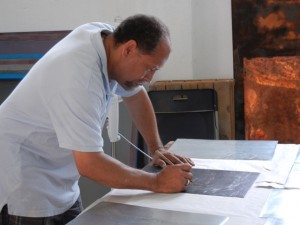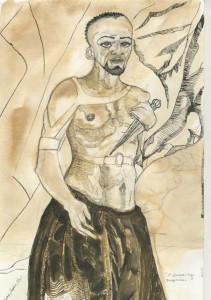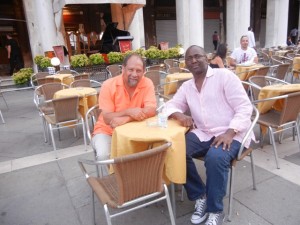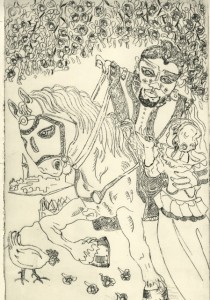
Professor Curlee Holton works in the Venice Printmaking Studio.
Working in the very city where the character Othello struggled against racial hostility, Curlee Holton has created a series of 10 images re-imagining Shakespeare’s character in the context of contemporary awareness of issues of race, identity, and culture.
Holton, Roth Professor of Art and founding director of the Experimental Printmaking Institute (EPI), made the Othello etchings while participating in the international Venice Printmaking Studio’s “Reflecting Venice” artist-in-residency program.
“I sought to bring a deeper sense of humanity and sensuality to Othello as well as a cultural context that might explain his motivations and actions,” says Holton.

One of the prints, "A Growing Suspicion"
As guests of the Venice Printmaking Studio, participating artists work on projects intended to contribute to the culture of Venice. During their stay in the city, participants document their individual experiences inspired by the city, its culture, monuments, art, and inhabitants.
“Reflecting Venice” will be a series of artists’ books produced by the Venice Printmaking Studio. Through the creation of the books, the studio asks artists to offer a critical perspective of the city beyond the standard visual images currently available in order to convey a sense of authenticity.
Prior to his trip, Holton created preliminary drawings in sepia ink, from which he then prepared etching plates during his time in Venice. Working there afforded him the opportunity to incorporate elements of the city’s scenery into his images.
Berrisford Boothe ’83, an internationally-renowned painter, printmaker, and installation artist and associate professor of art at Lehigh University, served as Holton’s model for the drawings.

Professors Holton and Smith in Venice
“I selected [Boothe] as my model for Othello due in part to the physical challenges he has faced as a result of being born with a number of physical handicaps, as well as for his regal presence and innate intelligence,” Holton says. “Much like Shakespeare’s Othello, Boothe personifies in many ways the strikingly royal presence yet is considered by many due to his perceived imperfections as flawed and overly passionate. Boothe allows for a contemporary context to be placed around Othello’s quest for acceptance and a hero’s adventure that as a person of color has seldom been allowed to be fully realized.”
Holton also invited Ian Smith, professor of English and an Othello specialist, to collaborate on the project.
“His insights into Shakespeare and the cultural, political, and racial context brought a great deal to the project and to my work,” Holton says.
 Holton’s images are a departure from 18th and 19th century depictions of Othello in staged scenes from Shakespeare’s play.
Holton’s images are a departure from 18th and 19th century depictions of Othello in staged scenes from Shakespeare’s play.
“This exhibit refrains from retelling the story, aiming instead to explore at a critical juncture the complex emotional and cultural life of a noble but beleaguered military hero,” Smith says. “The exhibit raises questions concerning the ways in which race, so relentlessly coded to the body, has been culturally constructed as a form of social and psychological impairment.”
Othello: Re-Imagined in Sepia, which is comprised of Holton’s prints and Smith’s text, is on display in the Lass Gallery of Skillman Library through December 2011.



 Holton’s images are a departure from 18th and 19th century depictions of Othello in staged scenes from Shakespeare’s play.
Holton’s images are a departure from 18th and 19th century depictions of Othello in staged scenes from Shakespeare’s play.
1 Comment
Comments are closed.